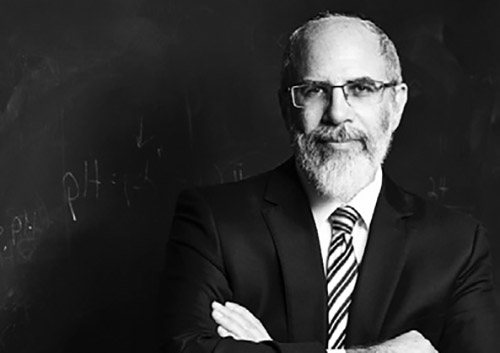
On February 17, a large audience gathered at Bais Yosef in Passaic to hear Dr. Henry Abramson, dean of Touro College in Brooklyn, speak about his recently published book, “Torah From the Years of Wrath: The Historical Context of The Aish Kodesh.”
In December of 1950, a Polish construction worker, while clearing rubble in the battered Warsaw Ghetto, made an astonishing discovery: two metal milk cans that contained a large collection of Jewish, Yiddish and Hebrew writings. This was a secret archive put together and hidden, before the razing of the ghetto, by a brave young historian, Emanuel Ringelblum, who created a secret society, Oneg Shabbat. “Ringelblum recruited a cadre of dedicated zamlers (collectors) and gave them the task of documenting every aspect of ghetto life,” noted Dr. Abramson.
One of the milk cans contained a precious document penned by a spiritual giant, eventually known to students as the Aish Kodesh, Rabbi Kalonymus Kalmish Shapira, the Piaseczna Rebbe. The document was a collection of weekly drashas on the parsha that the rebbe had delivered between September 1939 and July 1942.
The rebbe’s wartime writings were ultimately published, in 1960, under the name Aish Kodesh. Students of the rebbe the world over have studied Aish Kodesh to garner what they could from the martyred tzaddik’s spiritual journey through the war years.
Early on in Dr. Abramson’s dynamic lecture, he mentioned that nowhere in the rebbe’s writings will you find the words “Germany” or “Nazi.” Taken at face value, one could view the rebbe’s weekly drashas as unlinked to external events; however, as Dr. Abramson’s said, they were “a bleak chasidic meditation on the place of evil in Jewish thought.” Working with the large corpus of historical data now available, Abramson provided the nuanced background of what happened in the ghetto each week before the rebbe gave his drasha. Through the lens provided by “Torah from the Years of Wrath,” the missing link to specific events was filled, and modern-day students can see that the rebbe’s sermons did indeed revolve around the daily occurrences of the Holocaust and the Warsaw Ghetto. The drashas were his attempts to give comfort and chizuk to his followers no matter how horrific the circumstances they encountered that very week.
Rather than be controlled by these external events, the rebbe insisted throughout his drashas on placing the Holocaust within the grand scope and scheme of the Torah’s weekly message. The rebbe fully understood that words have power, and by giving the war and its atrocities no verbal power during the holy Shabbat he spoke volumes. The Holocaust in the rebbe’s writings would have to fit its evil self into the larger context of the Torah, the true blueprint for reality. What happened in the ghetto in any given week was not truth; the Torah was the Jews’ true reality, the kinder measure that his followers could keep coming back to for honest and comforting answers to their horrific pain.
During his lecture, Dr. Abramson cited many passages where the rebbe spoke through the parsha directly to the events. One example was when France fell under the control of the Nazis. This piece of news was a particular blow to the Jews of the ghetto. Now the Third Reich occupied all of Europe, from the English Channel to Russia. That week’s parsha was Shelach. The rebbe boldly underscored Kalev’s call to action to the Jews in the desert: “Let us go up,” despite the bad reports from the other spies. The rebbe asked in his drasha: “Why did Kalev not argue with them to rebut their rationale? Instead he said, ‘Let us go up.’” The rebbe continued, “Such must be the fate of the Jew. Not only when he sees an opening and path to his salvation…but also at a time when he does not see, Heaven forbid, any reasonable opening through the course of natural events for his salvation, he must still believe that God will save him.”
The rebbe never mentioned the fall of Paris. Why should he? All who attended his drasha knew of that bad report. Week after week the rebbe exhorted his congregation to see the correlation of their suffering to the weekly parsha, giving the message that their suffering mattered and had meaning.
As Abramson made clear, the rebbe personally endured the unbearable. At the beginning of the war, the rebbe’s only son was killed by mortar fire, and his daughter-in-law was killed the same day by the Luftwaffe while saying Tehillim for her husband who lay in the hospital in front of her. His only daughter was kidnapped in 1941 and was taken (it is believed) to Treblinka. His wife had died before the war. The rebbe saw it all, the worst of humankind, endured it all, and in the midst of it all found the loving hand of Hashem and conveyed God’s love to the bleeding Jews of the Warsaw Ghetto in a public document written in real time.
Now, because of Dr. Henry Abramson’s groundbreaking work, “Torah From The Years of Wrath,” we too can pull up a chair and know what they knew, and feel something of what they felt. And if we listen carefully, we can hear them.
By Alissa Joseph










